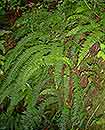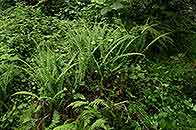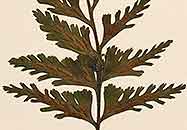Asplenium protensum Schrad.
Synonyms |
Asplenium protensum Schrad. var. pseudohorridum Hieron. |
|---|---|
Common name |
|
Description |
Rhizome up to 5 mm diameter, erect or sometimes shortly creeping; rhizome scales dark brown with pale lacerate margings, narrowly ovate-triangular in outline, up to 2 mm long. Fronds tufted, arching, herbaceous, proliferous towards the apex. Stipe 4-18 cm long; stipe and rhachis are thinly pubescent and covered with few ovate brown scales. Lamina 15-95 × 3-12 cm, narrowly lanceolate in outline, 2-pinnatifid, lower pinnae reduced, apical pinnae linear and lobed. Pinnae in 24-56 pairs, 2-7 x 0.8-1.7 cm, lanceolate in outline, incised 2/3 of the way to the midrib, base unequal, acroscopic basal lobe well developed, thinly pubescent above and below; lobes oblique, truncate and bifid. Sori 10-22, linear, 2-6.5 mm long, set at about 15 degrees to the midrib; indusium entire, linear, membranous. |
Notes | Differs from similar species by having proliferous fronds. |
Derivation | protensum: extended, referring to the long, narrow fronds. |
Habitat | Mostly on mossy boulders along deeply shaded streambanks in evergreen forest. |
Distribution worldwide | Africa, Mascarene Isl. |
Distribution in Africa |
Angola, Burundi, Cameroon, Dem. Republic of Congo, Equatorial Guinea (incl. Bioko), Eritrea, Ethiopia, Kenya, Malawi, Mozambique, Nigeria, Rwanda, Somalia, South Africa, Sudan and South Sudan, Tanzania , Uganda, Zambia, Zimbabwe. |
Growth form |
Epiphytic, lithophytic, terrestrial. |
Literature |
|




